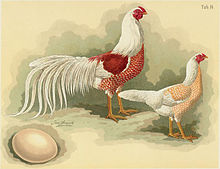Long-tailed chickens

Long-tailed chickens are originally Far Eastern ornamental chicken breeds, which through genetic modification do not or rarely lose the tail and saddle feathers during the moult , so that they are longer than average.
Origin and Distribution
Although indigenous long-tailed chicken breeds are no longer known in China today, based on old illustrations, it is assumed that these chickens originated in China. Roosters with extremely long tails are documented during the Edo period in Japan (around 1600 to 1860) in the Kochi district . At the end of the 19th century the first long-tailed chickens were brought to England and Germany , where attempts at crossbreeding led to the phoenix and Yokohama breeds . The spread of the Japanese breeds was made more difficult by an export ban on these animals. Even so, almost all Japanese long-tailed chicken breeds are bred outside of Japan and are for the most part recognized within organized breed poultry breeding .
Spring length
The genetic predisposition to decreased moulting of the tail and saddle feathers is attributed to the presence of the autosomal dominant gene Gt ("tail growth") and the autosomal recessive gene mt ("non-molting"). If the genes are fully expressed, the feathers can grow up to 1 meter per year. The world record is held by an Onagadori cock with a tail feather length of 10.59 meters.
Long-tailed chicken breeds
- Cubalaya
- Kurokashiwa
- Minohiki
- Ohiki
- Onagadori
- Phoenix
- Satsumadori
- Schijndelaar
- Shokoku
- Totenko
- Yokohama
Web link
Individual evidence
- ^ Brian Reeder: An Introduction to Form and Feathering of the Domestic Fowl, Author House, 2011, pp. 45-46
- ^ RD Crawford, Poultry breeding and genetics, Elsevier, Amsterdam 1990, pp. 176-177.
- ^ David Bird, The Bird Almanac: A Guide to Essential Facts and Figures of the World's Birds, Firefly Books, Buffalo (New York) 2004

